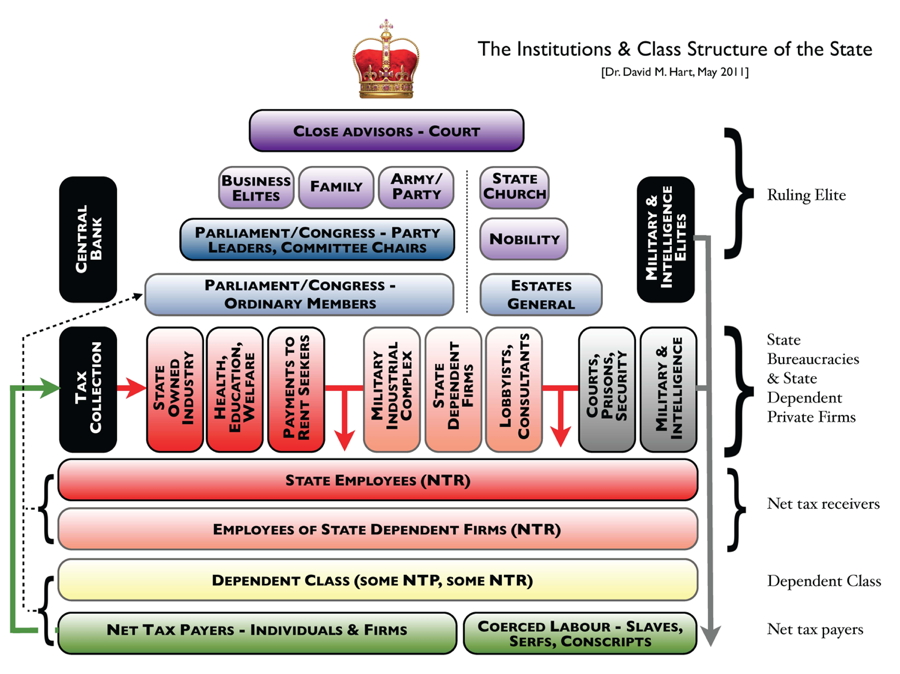
"The State and the Ruling Class"
A Lecture given at the
INSTITUTE FOR HUMANE STUDIES
"Liberty and Society" Summer SEMINARs 2012
[Updated: January 15, 2017]
 |
Eugène Delacroix, "Liberty Leading the People on the Barricades"
(1830) |
1. The State and the Ruling Class
- Lecture Slide Show
- [see selection of images on my blog]
- PDF version (single file) [PDF 8.9 MB]
- HTML version (click on the slide to advance to the next one)
- Other Lecture Material
- Video clips
- Terry Gilliam and Terry Jones, Monty Python and the Holy Grail (1975) - "the constitutional peasants"
- Additional material:
- A more detailed bibliography [PDF] [HTML]
- A collection of quotations about class and the State
- A summary page of my thoughts on the topic
- A collection of caricatures and images of the Ruling Class
 |
James Gillray, "The British Atlas, or John Bull supporting
the Peace Establishment (1816) |
Questions to Consider.
The State:
- what is the State and how does it function?
- who controls it?
- why has it grown so much over the past 100 years? & where is it heading now?
- is there an optimal size of the State & can it be limited to just these powers?
The Ruling Class:
- who has access to State power & what do they do with this power?
- what are the key power centres & who controls them?
- who benefits from this control (cui bono?) & what are these benefits?
- who pays for this?
- if the same group/s who benefit from State power persist over time, can we call them a “ruling class”?
- if the number of people who benefit from State power come to exceed the number who pay for it, how (in a democracy) can we ever return to a free society?
Key Recommended Reading & Films:
Murray Rothbard, "The Anatomy of the State" in Egalitarianism as a Revolt against Nature (2nd ed. Ludwig von Mises Institute, 2000). Online at the Mises Institute <http://mises.org/easaran/chap3.asp>.
Frédéric Bastiat, “The Physiology of Plunder,” in Economic Sophisms,
trans. Arthur Goddard (Irvington-on-Hudson: Foundation for Economic Education,
1968), pp. 129-46. Online at the Online Library of Liberty <http://oll.libertyfund.org/title/276/23376>.
David Hart’s “Schematic Diagram showing the Institutions and Class Structure of the State” <http://davidmhart.com/Guides/ClassTheory/ClassStructure-details%20/index.html>.
Film: See the clip from Terry Gilliam and Terry Jones, Monty Python and the Holy Grail (1975) on “The Constitutional Peasants” on my website <http://davidmhart.com/VideoClips/index.html>.
Images: See the collection of “Images of The Ruled as Atlas” on my website <http://davidmhart.com/Guides/ClassTheory/Atlas.html>.
Images: See some of my “Images of the Ruling Class” on my website <http://davidmhart.com/Guides/ClassTheory/ImagesOfRulingClass.html>.
Key Points
The Main Features of the State:
- the State has a monopoly of the use of force
- the State claims it has the sole legitimacy to exercise this force
- the State claims a monopoly in key sectors of the economy
- the State claims that different standard of morality applies to its actions
- the State needs obedient & compliant taxpayers & citizens who will “Obey & Pay”
- the State has an historical tendency to expand its powers
The Main Features of the Ruling Class:
- the Ruling Elite (RE) has privileged access to the key power centres of the state
- the RE can use this power to its own advantage (exclude rivals, protect allies, garner benefits)
- the RE uses state power to acquire benefits for itself such as wealth, status, & privilege, & to dispense benefits to its allies, clients, & favourites
- The State divides Society into two Rival Groups or Classes - the “net tax payers” (the ruled) and the “net tax receivers” (the ruling class)
- the State creates a “dependent class” which is reliant upon continued State benefits & which votes to maintain this
- The Sovereign Power makes Constantly Shifting Alliances with Vested Interests who are political “rent-seekers”
- Legislation socializes Costs and Privatizes Benefits for Favoured Groups
The Dynamic of the Growth of State Power & Class Rule:
- There are “dynamic” processes at work which tend to increase the power of the State over time.
- They indicate an instability or problem which needs to be solved.
- When the vested interests of ruling elites are combined with an ideology which favours government intervention these dynamics produce greater government intervention in economy/society.
- the dynamics of the growth of the State:
- Dynamic of Increasing Class Conflict
- Democratic Dynamic to Expand State Benefits to All
- Dynamic of the Limit to State Plundering
- Dynamic of the Higgsian Ratchet Effect of Crisis
- The Misesian Interventionist Dynamic
- The National Security Dynamic
1. Dynamic of Increasing Class Conflict
The Dynamic: there is rivalry/antagonism between those who receive benefits from the State and those who pay for those benefits.
- those who receive benefits wish to maintain or increase them,
- some who receive no benefits wish to join those who do, &
- those who pay for them wish to reduce or eliminate them
The Political Problem:
- there is an increasing number of “Net Tax Receivers” (State functionaries, beneficiaries of subsidies, dependent class)
- growing burden on the “Net Tax Payers” (fewer tax payers, increasing rates)
- Increasingly bitter Conflict between these 2 classes - as resources become scarcer
- the Net Tax Receivers will fight harder to preserve their payments from the State
- the Net Tax Payers will fight harder to reduce their payments to the State
- politicians will support the group which will best serves their interests (re-election)
2. Democratic Dynamic to Expand State Benefits to All
The Dynamic: Bastiat’s worry that in a democracy “everybody wants to live at the expence of everybody else”
- elected politicians gain & stay in power by pandering to these wishes
- this creates a built-in dynamic to expand State power, & increase debt & taxes
- creates a vested interest of State functionaries to service voters’ needs
- creates a vested interest of State Capitalists to lend money to fund State debt
- creates a vested interest of a dependent class which receives tax-funded benefits
The Political Problem: there are increasing demands of dependent class for benefits
- "baby boomer" generation entering retirement
- permanent "welfare class" has emerged since Great Society in 1960s
- socialist dream of universalising all government benefits (e.g. health care - "Obamacare")
3. Dynamic of the Limit to State Plundering
The Dynamic: The “Bastiat & the Malthusian Limit to Plundering” - plundering will continue to expand until all the resources available to the State are used up
- continue to expand if new sources of wealth are discovered
- will reduce its plundering when the plundered begin to resist and fight back (raise the costs of plundering)
The Political Problem: Bastiat's Malthusian Limits to Plundering are being approached
- the post-war economic boom has come to an end
- debt crisis in Europe and US to fund extravagant welfare state and/or military
- Keynesian "fiscal stimuli" reaching point of diminishing returns
- voter resistance to increased taxes & “austerity”
4. Dynamic of the Higgsian Ratchet Effect of Crisis
The Dynamic: periodic crises enable the political class to greatly increase size of government to solve the problem (clamour for govt “to do something”)
- internal crises - economic depression (1929, 2008), “terrorist” attack (9/11)
- external crises - war
- govt. responds to crisis with increased taxes, regulation, activity then reduces to some extent after crisis has passed - “ratchet effect” of steady growth of State
The Political Problem:
- 10 years of fear and panic of “terrorist attacks” in the US have led to 2-3 expensive wars paid largely by debt
- increased number of government agencies to gather and process intelligencecreation of entire new govt. departments (TSA)
- economic crisis of 2008 - bailouts of banks, GM car company, etc.
5. The Misesian Interventionist Dynamic
The Dynamic: all government interventions in the economy result in “unintended consequences” (e.g. price controls, minimum wages)
- original interventions leads to additional unforeseen problems which call for solution - either the original intervention must be revoked or additional govt. interventions must be enacted
- dynamic of interventionism - 20thC experience shows that States opt for latter approach, viz. steady growth in State regulation and power
The Political Problem:
- regulation expanding at steady rate (war on drugs, banking, environmental protection, "global warming", food and health (transfats))
- unintended bad consequences piling up (prison population, moral hazard, "green jobs" destroy jobs, etc)
6. The National Security Dynamic
The Dynamic: fear of invasion or attack by foreign enemy has been a common justification by the State for its “raison d’être” (reason for existence)
- repeatedly used to deflect criticism of its activity & justify secrecy
- WW1 and WW2 classic examples of need for citizens to make sacrifices in national interest
- need to “suspend” normal legal and moral rules of conduct
The Political Problem:
- increasing violation of personal rights (privacy of telephone calls, email, searching at airports)
- suspension of ban on torture for interrogating prisoners, & habeas corpus for trial and imprisonment
- presidential killing/assassination squad operating out of White House
- PATRIOT Act and ilk on books waiting to be used
- continuing undeclared wars (Yemen, Syria, Iran)
Additional Readings
Perry Anderson, Lineages of the Absolutist State (London: Verso, 1979) and Passages from Antiquity to Feudalism (London: Verso, 1979).
Arms, Politics, and the Economy: Historical and Contemporary Perspectives, ed. Robert Higgs, foreword by William A. Niskanen (New York: Holmes & Meier, 1990).
Frédéric Bastiat, “The State”, in Selected Essays on Political Economy, trans. Seymour Cain, ed. George B. de Huszar, introduction by F.A. Hayek (Irvington-on-Hudson: Foundation for Economic Education, 1995).
Martin van Crefeld, The Rise and Decline of the State (Cambridge University Press, 1999).
Robert B. Ekelund, Jr. and Robert D. Tollison, Mercantilism as a Rent-Seeking Society: Economic Regulation in Historical Perspective (Texas A&M University Press, 1981).
Robert Higgs, Crisis and Leviathan: Critical Episodes ion the Growth of American Government (New York: Oxford University Press, 1987).
Margaret Levi, Of Rule and Revenue (Berkeley: University of California Press, 1988).
Ludwig von Mises, “The Clash of Group Interests” in The Clash of Group Interests and Other Essays (The Center for Libertarian Studies, New York, 1978).
Albert Jay Nock, Our Enemy the State. Including “On Doing the Right Thing”, introduction by Walter E. Grinder (New York: Free Life Editions, 1973).
Franz Oppenheimer, The State: Its History and Development viewed Sociologically, authorized translation by John M. Gitterman (New York: B.W. Huebsch, 1922).
Murray Rothbard, "The Anatomy of the State" in Egalitarianism as a Revolt against Nature (2nd ed. Ludwig von Mises Institute, 2000).
Murray N. Rothbard, Power and Market: Government and the Economy (Menlo Park, CA: Institute for Humane Studies, 1970).
Ruling America: A History of Wealth and Power in a Democracy, ed. Steve Fraser and Gary Gerstle (Cambridge, MA: Harvard University press, 2005).
Charles Tilly, Coercion, Capital, and European States, AD 990-1990 Oxford: Basil Blackwell, 1990).
 |
The Institutions and Class Structure of the State [See the Key to the Schematic for explanations of the symbols] |